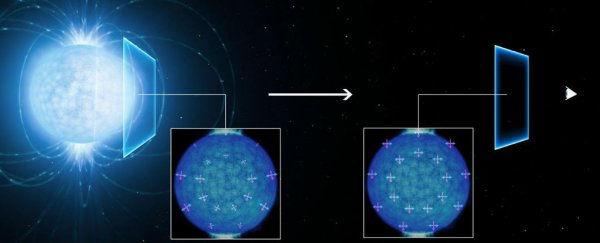For the first time, astronomers have observed a strange quantum phenomenon in action, where a neutron star is surrounded by a magnetic field so intense, it's given rise to a region in empty space where matter spontaneously pops in and out of existence.
Called vacuum birefringence, this bizarre phenomenon was first predicted back in the 1930s, but had only ever been observed on the atomic scale. Now scientists have finally seen it occur in nature, and it goes against everything that Newton and Einstein had mapped out.
"This is a macroscopic manifestation of quantum field," Jeremy Heyl from the University of British Columbia in Canada, who was not involved in the research, told Science. "It's manifest on the scale of a neutron star."
An international team of astronomers led by Roberto Mignani from INAF Milan in Italy made the discovery while observing a neutron star called RX J1856.5-3754 that's 400 light-years from Earth.
Neutron stars are the crushed cores of massive stars that collapsed under their own weight when they ran out of fuel, and exploded as a supernova.
They're made of some of the most dense material in the Universe - just 1 teaspoon of the stuff would weigh 1 billion tons on Earth - and their crust is 10 billion times stronger than steel.
Neutron stars also have the strongest magnetic fields in the known Universe - astronomers predict that the strongest neutron star magnetic fields are nearly 100 trillion times stronger than Earth's.
These magnetic fields are so ridiculous, they're thought to affect the properties of the empty space surrounding a neutron star.
In the classical physics of Newton and Einstein, the vacuum of space is entirely empty, but the theory of quantum mechanics assumes something very different.
According to quantum electrodynamics (QED) - a quantum theory that describes how light and matter interact - it's predicted that space is actually full of 'virtual particles' that pop in and out of existence and mess with the activity of light particles (photons) as they zip around the Universe.
These virtual particles aren't like regular physical particles like electrons and photons, but are fluctuations in quantum fields that have similar properties to a regular particle - the big difference being that they can appear and vanish at any point in space and time.
In regular empty space, photons aren't affected by these virtual particles, and travel without interference.
But in the empty space near the incredibly intense magnetic field of a neutron star, these virtual particles are 'excited', and they have a dramatic effect on any photons passing through.
"According to QED, a highly magnetised vacuum behaves as a prism for the propagation of light, an effect known as vacuum birefringence," Mignani explains in a press release.
"This effect can be detected only in the presence of enormously strong magnetic fields, such as those around neutron stars," adds team member Roberto Turolla from the University of Padua in Italy.
As Jay Bennett reports for Popular Mechanics, the researchers directed the world's most advanced ground-based telescope, the European Southern Observatory's Very Large Telescope (VLT), at their neutron star, and observed linear polarisation - the alignment of light waves influenced by electromagnetic forced - in the empty space around the star.
"This is rather odd, because conventional relativity says that light should pass freely through a vacuum, such as space, without being altered," says Bennett.
"The linear polarisation was to such a degree (16 degrees, to be precise) that the only known explanations are theories of QED and the influence of virtual particles."
You can see an illustration of this at the top of the page, where light coming from the surface of a neutron star (on the left) becomes linearly polarised as it travels through the vacuum of space on its way to the observer on Earth (on the right).
The next step now is for the observations to be replicated in another scenario to know for sure that vacuum birefringence is what we're looking at here, and if that's the case, we've got a whole new phenomenon to investigate in the field of quantum mechanics.
"When Einstein came up with the theory of general relativity 100 years ago, he had no idea that it would be used for navigational systems. The consequences of this discovery probably will also have to be realised on a longer timescale," Magnani told New Scientist.
The research has been published in Monthly Notices of the Royal Astronomical Society, and you can access it for free at arXiv.org.
